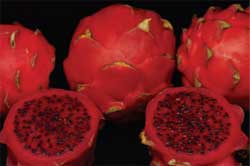|
|



|
Family: Cactacae
Genus: Hylocereus
Species: H. undatus
Common Names: Pitaya (English), Pitahaya (Spanish), Wob (Maya), Red Pitaya, Red Pitahaya, Night blooming Cereus, Strawberry Pear, Dragonfruit, Belle of the Night, Conderella Plant, Handsome by Night
Parts Used: Fruit, Seed, juice, Leaves
| PLANT DESCRIPTION | Documented Properties
& Actions: | Antiseptic, diuretic, emmenagogueue, parasiticide, vulnerary
| Plant
Chemicals
Include:
| All of them.
|
Stems scandent, creeping, sprawling or clambering, branching profusely, 4-7,5 (-10) m long or more, joints to 30-120 cm long or more, 10-12 cm thick; ribs generally 3; margins corneous in age, undulate; areoles 2 mm in diameter; internodes 1-4 cm; spines on adult branches 1-3, 2-4 mm long, acicular to subconic, grayish brown to black, spreading; epidermis deep green. Flowers 25-30 cm long, 15-17 cm wide, nocturnal, scented; pericarpel 2,5-5 cm long, ca 2,5 cm thick, bracteoles ovate, acute, to 2,5 (-4 ) cm long; receptacle ca 3 cm thick, bracteoles linear-lanceolate, 3-8 cm long; outer tepals lanceolate-linear to linear, acuminate, 10-15 cm long, 10-15 mm wide mucronate, greenish yellow or whitish, rarely tinged rose; inner tepals lanceolate to oblanceolate, to 10-15 cm long ca 40 mm wide at widest point, mucronate, entire, acute to acuminate, white; stamens 5-10 cm long, declinate, inserted in one continuous zone from throat to 35 mm above pericarpel, cream; style to 17,5-24.5 cm long, stout, 6-8 mm thick, cream, stigma lobes to 26, entire or sometimes cleft at apex, cream, ca 25 mm long. Nectar chaimbers 30 mm long. Fruit oblong to ovoid, to 6-12 cm long, 4-9 cm thick, red with large bracteoles, pulp white, edible; seeds black.
Description The origin of this plant are the subject of controversy with some authorities claiming it is native to southeast Asia, while others claim its origin is in northwestern South America. Fossil records from New Zealand indicate that small, coconut-like plants grew there as far back 15 million years ago. Even older fossils have been uncovered in Rajasthan & Maharashtra, India. Regardless of its origin, the coconut has spread across much of the tropics, probably aided in many cases by sea-faring peoples. The fruit is light and buoyant and presumably spread significant distances by marine currents: fruits collected from the sea as far north as Norway have been found to be viable (subsequently germinated under the right conditions). In the Hawaiian Islands, the coconut is regarded as a Polynesian introduction, first brought to the Islands by early Polynesian voyagers from their homelands in the South Pacific.
BIBLIOGRAPHY
Anderson, E. F. 2001. The cactus family. Timber Press, Portland, Oregon, USA.

|
|